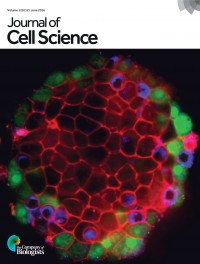
ISSN: 0021-9533
Journal Home
Journal Guideline
Journal of Cell Science Q2 Unclaimed
Journal of Cell Science is an international peer-reviewed journal in the field of cell biology that is published by The Company of Biologists, a not-for-profit charitable organisation run by biologists for the benefit of the biological community. Journal of Cell Science is committed to publishing the full range of topics in cell biology, and the single most important criterion for acceptance is scientific excellence. Articles must therefore pose and test a significant hypothesis that will provid It has an SJR impact factor of 1,479.
Journal of Cell Science focuses its scope in these topics and keywords: protein, signaling, cell, assembly, expression, golgi, human, induces, mediated, receptor, ...
Type: Journal
Type of Copyright: CC BY
Languages: English
Open Access Policy:
Type of publications: Research reports, Short report
Publication frecuency: -


3110 €
Inmediate OA0 €
Embargoed OA- €
Non OAMetrics
1,479
SJR Impact factor319
H Index312
Total Docs (Last Year)1299
Total Docs (3 years)19362
Total Refs3495
Total Cites (3 years)1127
Citable Docs (3 years)2.47
Cites/Doc (2 years)62.06
Ref/DocOther journals with similar parameters
Molecular Biology of the Cell Q2
Journal of Cellular and Molecular Medicine Q2
Mitochondrion Q2
Cellular Signalling Q2
Mediators of Inflammation Q2
Compare this journals
Aims and Scope
Best articles by citations
Conserved and specific functions of axoneme components in trypanosome motility
View moreIn yeast, the pseudohyphal phenotype induced by isoamyl alcohol results from the operation of the morphogenesis checkpoint
View moreSticky worms: adhesion complexes in C. elegans
View moreThe Chironomus tentans translation initiation factor eIF4H is present in the nucleus but does not bind to mRNA until the mRNA reaches the cytoplasmic perinuclear region
View moreMigrating fibroblasts perform polarized, microtubule-dependent exocytosis towards the leading edge
View moreMinimal mutations are required to effect a radical change in function in CEA family members of the Ig superfamily
View moreThe 5T4 oncofoetal antigen is an early differentiation marker of mouse ES cells and its absence is a useful means to assess pluripotency
View moreControl of embryonic Xenopus morphogenesis by a Ral-GDS/Xral branch of the Ras signalling pathway
View moreDynein-dependent nuclear dynamics affect morphogenesis inCandida albicansby means of the Bub2p spindle checkpoint
View moreThe Drosophila FHOD1-like formin Knittrig acts through Rok to promote stress fiber formation and directed macrophage migration during the cellular immune response
View moreThe C-terminal domain of Drosophila Heavy-spectrin exhibits autonomous membrane association and modulates membrane area
View moreCdc14: a highly conserved family of phosphatases with non-conserved functions?
View moreCryptic O2--generating NADPH oxidase in dendritic cells
View moreIntracellular localization and dynamics of myosin-II and myosin-IC in live Acanthamoeba by transient transfection of EGFP fusion proteins
View moreThe formin family protein CaBni1p has a role in cell polarity control during both yeast and hyphal growth in Candida albicans
View morePreconditioning-induced cytoprotection in hepatocytes requires Ca2+-dependent exocytosis of lysosomes
View moreDysfunction of CFTR bearing the F508 mutation
View moreSchizosaccharomyces pombe Rgf3p is a specific Rho1 GEF that regulates cell wall -glucan biosynthesis through the GTPase Rho1p
View moreRab11 regulates the recycling and lysosome targeting of 2-adrenergic receptors
View moreIntegrin a9beta1 is a receptor for nerve growth factor and other neurotrophins
View moreActivity of Cdc2 and its interaction with the cyclin Cdc13 depend on the molecular chaperone Cdc37 in Schizosaccharomyces pombe
View moreDevelopmental-stage-specific triacylglycerol biosynthesis, degradation and trafficking as lipid bodies in Plasmodium falciparum-infected erythrocytes
View moreLocalization of GDP-mannose transporter in the Golgi requires retrieval to the endoplasmic reticulum depending on its cytoplasmic tail and coatomer
View moreGenetically encoded molecular probes to visualize and perturb signaling dynamics in living biological systems
View more
Comments